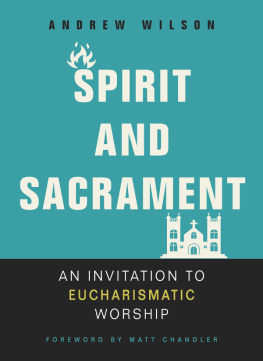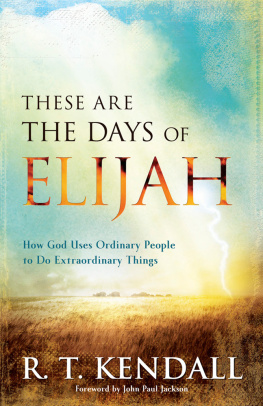Andrew Wilson is one of my favorite writers. And this book reminds me why. He displays a gift for weaving biblical theology with everyday illustrations that leads me to worship God. In this book, youll get to know Gods Word more deeply. And youll never look at the world the same way.
C OLLIN H ANSEN , editorial director, The Gospel Coalition; host, Gospelbound podcast
Reading each chapter, I marveled anew at the kindness of God to instruct his children with such gentle care.
J EN W ILKIN , author, None Like Him
Creation was always meant to point beyond itself, and Andrew Wilson shows us the myriad and wonderful ways in which it does. This book is packed with insight and nourishment on every page. I found myself pointed to Christ in so many surprising and fresh ways, and provoked to worship a God of such grace and beauty.
S AM A LLBERRY , pastor and author
A treasure of a book from Andrew, and one that I didnt want to finish. Seeing God through everything he has made is sheer delight.
T ERRY V IRGO , founder, Newfrontiers
What a wonderful book! God of All Things caught my attention from the start, reminding me that all Gods worksand I do mean allproclaim his glory. From rainbows to donkeys to everyday tools, the things of this life really do reveal the God of life. This book is a delightful primer in learning how to truly see things for what they are.
H ANNAH A NDERSON , author, Turning of Days: Lessons from Nature, Season, and Spirit
ZONDERVAN REFLECTIVE
God of All Things
Copyright 2021 by Andrew Wilson
Requests for information should be addressed to:
Zondervan, 3900 Sparks Dr. SE, Grand Rapids, Michigan 49546
Zondervan titles may be purchased in bulk for educational, business, fundraising, or sales promotional use. For information, please email SpecialMarkets@Zondervan.com.
ePub Edition January 2021: ISBN 978-0-310-10909-9
All Scripture quotations, unless otherwise indicated, are taken from the ESV Bible (The Holy Bible, English Standard Version). Copyright 2001 by Crossway, a publishing ministry of Good News Publishers. Used by permission. All rights reserved.
Scripture quotations marked NIV are taken from The Holy Bible, New International Version, NIV. Copyright 1973, 1978, 1984, 2011 by Biblica, Inc. Used by permission of Zondervan. All rights reserved worldwide. www.Zondervan.com. The NIV and New International Version are trademarks registered in the United States Patent and Trademark Office by Biblica, Inc.
Any internet addresses (websites, blogs, etc.) and telephone numbers in this book are offered as a resource. They are not intended in any way to be or imply an endorsement by Zondervan, nor does Zondervan vouch for the content of these sites and numbers for the life of this book.
All rights reserved. No part of this publication may be reproduced, stored in a retrieval system, or transmitted in any form or by any meanselectronic, mechanical, photocopy, recording, or any otherexcept for brief quotations in printed reviews, without the prior permission of the publisher.
Published in association with the literary agency of Wolgemuth & Associates, Inc.
Cover illustration and design: Conrad Garner
Interior design: Denise Froehlich
20 21 22 23 24 /LSC/ 10 9 8 7 6 5 4 3 2 1
Information about External Hyperlinks in this ebook
Please note that footnotes in this ebook may contain hyperlinks to external websites as part of bibliographic citations. These hyperlinks have not been activated by the publisher, who cannot verify the accuracy of these links beyond the date of publication.
For Andy and Janet Johnston, who taught me how to be a pastor and showed me how to preach from things
When is a building more than a building?
As I was reading the book you now hold, I found my mind returning to the church of my childhood. I spent many Sunday mornings in the sanctuary of the First United Methodist Church of Wichita Falls, Texas. Small towns in Texas are unexpected places to stumble on grandeur, but the wealthy oil barons of the early twentieth century left behind a few architectural gems. First Methodist was modeled on the design of a gothic cathedral, its soaring sanctuary wreathed in stained glass and carvings, with a massive rose window filling the chancel.
Since I am now a full-time Bible teacher, I would like to tell you I always paid rapt attention to the Sunday sermon. But the truth is my attention often wanderedto the windows, the carvings, and the items tucked into the pew rack in front of me. There, next to the hymnal and the attendance folio, was a small booklet titled Eye Gate: Sermons in Symbols, written by Eleanor M. Robbins. The booklet was filled with explanations of the images that surrounded me in glass and stone and wood, each carefully chosen to teach a truth about God.
So while I often failed to listen carefully to the sermon, I nevertheless learned that the peaked windows and arches of the sanctuary were meant to resemble hands folded in prayer. I learned that the seven steps from the nave to the altar symbolized the seven attributes of the Lamb written in Revelation 5. The rose window contained six doves to represent the gifts of the Spirit prophesied in Isaiah 11:12. There were pomegranates and lilies, stars and flames, thorns and chalices and clovers, each image or item echoing a biblical truth. The light fixtures were designed to look like censers, representing the prayers of the saints rising to God. Worked into the front of the pulpit was an intertwined monogram of the Greek letters alpha and omega. The entire building was preaching the Word of God in symbol, all without uttering a word.
When is a rose window more than a rose window?
In the tradition of the medieval gothic architects of Europe, the architects of First United Methodist Church constructed a building not just to dazzle the eyes but also to teach. Deliberately and masterfully, they designed a space that repeated the words of Scripture in memorable ways through stone and glass and wood. Any passing visitor to the church, Christian or not, would be moved to wonder by the beauty of the space they had designed. But those who recognized its symbols would be moved to worship and remembrance.
The Bible, too, is the work of an architect, though we sometimes forget this. Through the pens of human authors, that divine architect has filled our sacred text with carefully chosen imagery. Many readers have remarked on the Bibles poetry or its historical narratives, but those with an eye for its imagery will be moved to worship and remembrance. Each of the authors of the sixty-six books of the Bible shares something in common with those cathedral builders: a commitment to teach through repetition what is true about God in memorable ways.
When is a mountain more than a mountain? When is a garden more than a garden?
We live in a time when our education systems often fail to teach us how to properly read literaturewith an eye for authorial intent. We approach a book assuming that it is our job to assign it meaning, asking, What does this book mean to me? But the work of the reader, properly understood, is not to assign their own personal meaning to a text but to uncover the meaning the author intended to convey. No author sits down to write without first considering how and what they wish to communicatethe architectural design behind what they are writing. No author puts pen to paper or fingers to keyboard without first asking, How can I help my reader arrive at a proper understanding of my message?
















